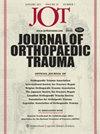Comparison of Operative and Non-Operative Management of Elderly Fragility Pelvic Ring Fractures
IF 1.6
3区 医学
Q3 ORTHOPEDICS
引用次数: 0
Abstract
To compare outcomes of nonoperative and percutaneous fixation of geriatric fragility lateral compression I (LC1) pelvic ring fractures. Design: Retrospective Two level one trauma centers Included were patients 60 years of age or older with an isolated LC1 pelvic ring fracture managed nonoperatively or those who failed mobilization and were managed operatively with percutaneous sacral fixation after failing to mobilize. Patients with high energy mechanisms of injury or polytrauma were excluded. Outcome Measures and Comparisons: The primary outcome was pain as measured by Visual Analog Scale (VAS) after treatment. Secondary outcomes included length of stay (LOS), discharge disposition, mortality, readmission rates, and complications. In total, 231 patients were included with a mean age of 79.5 years (range 60-100). One hundred eighty-five(80.0%) patients were female. Sixty-two (26.8%) patients received percutaneous sacral fixation after failed mobilization, and 169 (73.2%) were managed nonoperatively. In the operative group, the median time to surgery was hospital day four. Nonoperative patients were older (81.5 ± 10.0 years vs. 74.2 ± 9.4 years, p<0.01), and had a shorter hospital LOS (4.8 ± 6.2 days) than the operative group (10.6 ± 9.5 days, p<0.01). Patients in the operative group had more pain (VAS 7.9 ± 3.0) than the nonoperative group (VAS 6.6 ± 3.0) (p=0.01) on admission, but had similar pain control post-operatively (VAS 4.4 ± 3.0) compared to the nonoperative group (VAS 4.5 ± 3.6) on the equivalent hospital day (p=0.91). Thus, patients in the operative group experienced more improvement in pain (VAS 3.3 ± 2.7) compared to the nonoperative group (VAS 1.9 ± 3.9) after treatment (p=0.02). Ninety-day mortality (p=0.21) and readmission rates (p=0.27) were similar for both groups. Two patients in the operative cohort sustained nerve injuries, while one patient in the nonoperative group had a nonunion and underwent surgery. Patients who undergo percutaneous surgical fixation for low energy LC1 injuries have similar discharge disposition, mortality, complication rates, and readmission rates compared to patients treated nonoperatively. Percutaneous surgical fixation may provide significant pain relief for patients who failed conservative management. Therapeutic Level III. See Instructions for Authors for a complete description of levels of evidence.老年脆性骨盆环骨折的手术和非手术疗法比较
比较老年脆性侧方压缩 I 型(LC1)骨盆环骨折的非手术治疗和经皮固定治疗的效果。 设计:回顾性研究 两家一级创伤中心 纳入了 60 岁或以上的孤立性 LC1 骨盆环骨折患者,这些患者接受了非手术治疗,或在活动失败后接受了经皮骶骨固定手术治疗。高能量损伤或多发性创伤患者除外。结果测量和比较:主要结果是治疗后的疼痛,以视觉模拟量表(VAS)进行测量。次要结果包括住院时间(LOS)、出院处置、死亡率、再入院率和并发症。 共纳入 231 名患者,平均年龄为 79.5 岁(60-100 岁不等)。185名(80.0%)患者为女性。62名(26.8%)患者在活动失败后接受了经皮骶骨固定术,169名(73.2%)患者接受了非手术治疗。手术组的中位手术时间为住院第四天。非手术组患者年龄较大(81.5 ± 10.0 岁 vs. 74.2 ± 9.4 岁,P<0.01),住院时间(4.8 ± 6.2 天)短于手术组(10.6 ± 9.5 天,P<0.01)。手术组患者入院时的疼痛程度(VAS 7.9 ± 3.0)高于非手术组(VAS 6.6 ± 3.0)(P=0.01),但术后疼痛控制情况(VAS 4.4 ± 3.0)与同等住院日的非手术组(VAS 4.5 ± 3.6)相似(P=0.91)。因此,手术组患者在治疗后的疼痛改善程度(VAS 3.3 ± 2.7)高于非手术组(VAS 1.9 ± 3.9)(P=0.02)。两组患者的九十天死亡率(P=0.21)和再入院率(P=0.27)相似。手术组中有两名患者出现神经损伤,而非手术组中有一名患者出现骨不连并接受了手术。 与非手术治疗的患者相比,接受经皮手术固定治疗低能量 LC1 损伤的患者的出院处置、死亡率、并发症发生率和再入院率相似。对于保守治疗失败的患者,经皮手术固定可显著缓解疼痛。 治疗级别 III。有关证据等级的完整描述,请参阅 "作者须知"。
本文章由计算机程序翻译,如有差异,请以英文原文为准。
求助全文
约1分钟内获得全文
求助全文
来源期刊

Journal of Orthopaedic Trauma
医学-运动科学
CiteScore
3.90
自引率
8.70%
发文量
396
审稿时长
3-8 weeks
期刊介绍:
Journal of Orthopaedic Trauma is devoted exclusively to the diagnosis and management of hard and soft tissue trauma, including injuries to bone, muscle, ligament, and tendons, as well as spinal cord injuries. Under the guidance of a distinguished international board of editors, the journal provides the most current information on diagnostic techniques, new and improved surgical instruments and procedures, surgical implants and prosthetic devices, bioplastics and biometals; and physical therapy and rehabilitation.
 求助内容:
求助内容: 应助结果提醒方式:
应助结果提醒方式:


